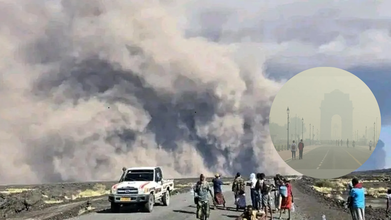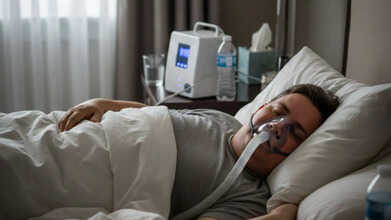- Health Conditions A-Z
- Health & Wellness
- Nutrition
- Fitness
- Health News
- Ayurveda
- Videos
- Medicine A-Z
- Parenting
5 Tests Your GP Isn’t Ordering, But Could Spot A Disease Even Before Symptoms Appear, According to Doctor

Credits: Canva
It is not hidden that India indeed is the diabetes capital of the world. As per the World Health Organization (WHO), at least 77 million people in the country are living with diabetes, and 25 million of them are prediabetic. Not only that, but there has been an increase in chronic conditions in India too, all thanks to the lifestyle. In fact, as per the Indian Council of Medical Research, 56.4% of the total disease burden in India comes from unhealthy diets. This has led to cardiovascular diseases, cancers, respiratory diseases, and high cholesterol.
So, how can someone stay a step ahead of all that? Dr Brijmohan Arora, a senior diabetologist from Delhi suggested 5 biomarkers that can help you stay a step ahead of the chronic diseases. These tests can help you live a longer and healthier life.
“Most doctors still rely on superficial tests, but in 2025 we have far more powerful biomarkers to predict your future health,” says Dr Arora. The doctor explains that basic tests like a standard lipid or cholesterol panel only give a surface level picture, however, advanced biomarkers dig deeper and can help in catching risks earlier and reveal what is happening inside your blood vessels and metabolism even before the disease shows up.
The Five Biomarkers To Keep You Healthy
ApoB
“ApoB is like a bullet that enters your arteries, it’s the most advanced and accurate form of cholesterol testing," the doctor says.
What ApoB means:
- ApoB (Apolipoprotein-B) counts the actual number of harmful cholesterol-carrying particles in your blood.
- These particles directly drive plaque formation.
- It is more predictive of heart attack risk than LDL alone.
Why it matters:
Two people with the same LDL cholesterol can have very different ApoB levels. The one with higher ApoB is at higher risk. The doctor calls it the "single most accurate marker of heart-attack risk".
HS-CRP
“High-sensitivity CRP and homocysteine are inflammation markers, they help predict inflammation of the heart and blood vessels,” he says.
What hs-CRP means:
- A highly sensitive test that detects tiny amounts of inflammation, especially in arteries.
- Elevated hs-CRP is linked to heart attacks, stroke, plaque instability, and chronic disease.
What Homocysteine means:
An amino acid that, when elevated, increases risk of blood clots, heart attacks, and cognitive decline.
Often linked to vitamin B12 or folate deficiency.
Why they matter:
They don’t diagnose disease… they predict risk, which makes them powerful preventive markers.
Homocysteine
It is an amino acid that is naturally found in the blood that can be harmful to the lining of the artery walls when levels are high. Its levels are influenced by factors like vitamin deficiencies (especially B12, B6, and folate), genetics, and kidney disease. Dr Arora notes that high levels of this could mean higher risk of stroke, dementia, and clotting diseases.
Fasting Insulin
“Fasting insulin gives us a window into the future, it picks up abnormalities long before sugar levels rise.”
What Fasting Insulin means:
- Measures how hard your pancreas is working to keep your sugar normal.
- High fasting insulin = early insulin resistance.
Why it matters:
You can have completely normal glucose and HbA1c, yet be on the path to prediabetes, diabetes, obesity, fatty liver, and PCOS years in advance.
This test detects problems before they appear on regular reports.
Omega-3 Index
“Omega-3 Index gives deep insight into your metabolic health and risk of conditions like Alzheimer’s.”
What Omega-3 Index means:
Measures the percentage of omega-3 fatty acids in your red blood cells.
Higher levels are linked to:
- Better metabolic health
- Lower inflammation
- Heart protection
- Improved brain function
- Lower dementia risk
Why it matters:
Few labs offer it, but it’s one of the strongest markers of long-term inflammation and cell health.
Volcanic Ash From Ethiopia Is Drifting Toward India, Should Delhi Be Worried?

Credits: AP, ANI
For the first time in 12,000 years, the Ethiopian Hayli Gubbi volcano has erupted. The volcanic plumes has already traveled thousands of kilometer to India and has reached altitudes between 25,000 and 45,000 feet. It has affected Delhi-NCR, Gujarat, Punjab, and Rajasthan, and several other parts of North India. As per the reports, the speed at which the plumes are travelling is at nearly 100 to 120 km/hour at altitudes above 10 km. The plumes contains volcanic ash, sulphur dioxide, and small particles of glass and rock.
Amid Delhi's continuously worsening air pollution, the question rises whether the plumes and the chemicals it contains will impact Delhi's air and the air quality.
Can The Ethiopian Volcanic Plumes Impact Delhi?
The volcanic plumes reached Delhi around 11pm, confirmed the India Meteorological Department (IMD). As per News 18, some residents noticed an unusually diffused, cloud-like haze. However, IMD Director General M Mohapatra said that any significant deterioration in Delhi's air quality is unlikely.
Mohapatra explained that the ash is circulating at high altitudes, which is well above where Delhi's pollution typically concentrates. “It is unclear whether it will impact air quality, but any significant impact is unlikely as it is at higher levels," because plume is in the "upper levels". The Director General noted that there will only be a "marginal rise in temperature" as the ash could behave like cloud cover and absorb and re-radiate heat. However, in terms of Delhi's air quality, he noted that any influence near the ground would be "marginal".
However, the volcanic plumes have impacted flight operations in and around the Indian airspace. Airlines cancelled flights, with IndiGo grounding six flights. Akasa Air said its flights to and from Jedda, Kuwait, and Abu Dhabi scheduled for today and November 24 have been cancelled. KLM Royal Dutch Airplines too cancelled its Amsterdam-Delhi and return flights. IndiGo on X said, "Following the recent eruption of the #HayliGubbi volcano in #Ethiopia, ash clouds are reported to be drifting towards parts of western India. We understand that such news may cause concern, and we want to reassure you that your safety remains our highest priority".
The plumes are expected to head towards China next. It is expected to leave India by 14:00 GMT (7:30 pm local time) on Tuesday.
Can Volcanic Eruption Impact Health Of Those Who Live Near It?
As per the Centers for Disease Control and Prevention (CDC), volcanoes are geographical formations where lava, small rocks, and steam are released onto the surface of the earth.
When a volcano erupts, it can release harmful particles, including volcanic gases and ash, into the air. These volcanic gases may have an adverse impact on your health, including:
- Carbon Dioxide (CO2)
- Sulfur Dioxide (So2)
- Hydrogen Chloride (HCL)
- Hydrogen Sulfide (H2s)
- Radon (Rn)
- Hydrogen Fluoride (HF)
- Sulfuric Acid (H2SO4)
How Each Toxic Gas Impacts Health
Carbon Dioxide
As per the USDA Food and Safety Inspection Service, CO2 is colorless, odorless, non-flammable gas that naturally occurs in the atmosphere. As the CDC mentions, it is also released when a volcanic eruption takes place. CO2 is considered to be minimally toxic by inhalation. The primary health effects caused by CO2 are the result of its behavior as a simple asphyxiant.
A simple asphyxiant is a gas which reduces or displaces the normal oxygen in breathing air.
Symptoms of mild CO2 exposure may include headache and drowsiness. At higher levels, rapid breathing, confusion, increased cardiac output, elevated blood pressure, and increased arrhythmias may occur. Breathing oxygen-depleted air caused by extreme CO2 concentrations can lead to death by suffocation.
Sulfur Dioxide
As per the National Park Service, Sulfur dioxide is a colorless, reactive air pollutant with a strong odor. This gas can be a threat to human, animal and plant health.
It can irritate the skin and mucous membranes of the eyes, nose, throat, and lungs. High concentrations of SO2 can also cause inflammation and irritation of the respiratory system. This can then lead to pain when taking deep breaths, coughing, throat irritation and breathing difficulties. This gas can further affect lung function, worsen asthma attacks, and exacerbate existing heart diseases.
Hydrogen Chloride
As per the CDC, hydrogen chloride is a colorless to slightly yellow gas with a pungent odor. On exposure to air, the gas forms dense white vapors due to condensation with atmospheric moisture.
Upon inhalation, the odor could irritate and affect the lungs. While it cannot be absorbed through the skin, its direct contact could irritate the skin and cause chemical burns. The ingestion could also lead to corrosive injury to the lips, mouth, throat, esophagus, and stomach.
Hydrogen Sulfide
As per the US Department of Labor, hydrogen sulfide causes a wide range of health effects, especially if you breathe it and are exposed to it for a longer duration. Its exposure to very high concentrations could also lead to death.
It is a highly flammable, explosive gas, and can cause a life-threatening situation when not handled properly. Its exposure to skin can cause "blue skin" or frostbite.
Radon
As per the US Environmental Protection Agency, radon could lead to lung cancer. It is also the number one cause of lung cancer among non-smokers.
Hydrogen Fluoride
As per the CDC, it is also a colorless gas or liquid that could cause severe damage to the body. The effects could also depend on how long one is exposed to the gas. If it is breathed in, it can irritate the eyes and respiratory tract. Breathing in a large amount could cause death from irregular heartbeat or from fluid buildup in the lungs. It can also cause rash and deep, slow-healing burns.
Sulfuric Acid
As per the Department of Climate Change, Energy, the Environment and Water run by the Australian Government, sulfuric acid is the world's largest volume industrial chemical. It is corrosive in nature and can severely burn the skin and eyes. It can also cause third-degree burns and blindness on contact. It can also irritate the eyes, nose, throat, and lungs.
UK Health Experts Issue Antibiotics Alert For Cold and Flu; Here’s Why

Credits: Canva
Health authorities in the United Kingdom have released a fresh advisory on the use of antibiotics this winter. The UK Health Security Agency (UKHSA) reminded the public that these medicines are designed for specific types of illness and are not useful in every situation.
Antibiotics treat or prevent bacterial infections by killing the bacteria outright or limiting their ability to grow. This allows the body’s own immune defences to clear the remaining infection. What they cannot do is treat illnesses caused by viruses.
This includes common winter infections such as colds, flu, and COVID-19. In a post on X, the UKHSA said, “Antibiotics don't work for colds and flu. Pharmacists can guide you on managing your symptoms.”
Health Officials Issue Winter Antibiotics Warning
The agency also urged people to keep a few basic points in mind when using antibiotics:
- Do not use them for colds or flu
- Do not keep unfinished courses for future use
- Always take them according to instructions
Flu And Cold: Why The Warning Matters
The reminder follows the release of the UKHSA’s English Surveillance Programme for Antimicrobial Utilisation and Resistance (ESPAUR) report, which shows that nearly 400 people in England each week are now diagnosed with infections that no longer respond well to antibiotics. These resistant infections are harder to treat and pose a greater risk of complications.
Experts believe that years of unnecessary or incorrect use of antibiotics have contributed to a decline in their effectiveness. This widespread overuse has also encouraged the rise of “superbugs”, a term used for bacteria that can withstand several commonly used antibiotics. Examples highlighted by the NHS include:
- MRSA (methicillin-resistant Staphylococcus aureus)
- Clostridium difficile (C. diff)
- The bacteria responsible for multi-drug-resistant tuberculosis
The NHS notes that these infections can be severe, difficult to control, and are becoming a growing cause of illness and death worldwide. The larger concern is that entirely new bacteria may emerge with resistance to every antibiotic currently available.
Cold Symptoms
A cold usually develops slowly and tends to be milder. Typical signs include a runny or blocked nose, sneezing, a sore throat, mild cough, slight body ache, and low fever if any. Many people also feel pressure around the sinuses and a mild headache.
Flu Symptoms
Flu sets in quickly and is generally more intense. People often experience a high fever, chills, deep muscle pain, marked fatigue, headache, dry cough, sore throat, and a sudden drop in energy. Some may also have nausea, loss of appetite, or chest discomfort.
What Experts Are Saying
Dr Alicia Demirjian, consultant epidemiologist and clinical lead for antimicrobial resistance and prescribing at the UKHSA, said, “Antibiotic resistance is one of the biggest threats facing modern medicine, but the good news is we can all do something about it.”
If a doctor has prescribed antibiotics, it is vital to take the medicine exactly as told, without skipping or delaying doses.
The NHS advises, “If you miss a dose, check the patient information leaflet to see what to do. If you are unsure, speak with a pharmacist or your GP. In many cases, you can take the missed tablet as soon as you remember and then continue the course as usual. If it is almost time for your next dose, leave out the missed one and return to your usual schedule.”
Weight Loss Drug Mounjaro Gets Nod For Sleep Apnea: How Does It Work?

Credits: Gemini
A very common medical condition globally, sleep apnea is a disorder that interrupts breathing during sleep. Several factors can cause it, though the risk rises sharply with obesity because extra fat in the neck, known as pharyngeal fat, can narrow the airway. Health professionals usually advise lifestyle changes such as diet and exercise to ease symptoms, but if these steps do not help enough, weight-loss injections may be recommended.
Australia’s Therapeutic Goods Administration (TGA) has now approved the weight-loss drug Mounjaro as a treatment option for sleep apnea, a condition where a person repeatedly stops and starts breathing through the night. The TGA states that Mounjaro may be used for adults with moderate to severe obstructive sleep apnea who also meet the criteria for obesity with a body-mass index of 30 or more.
The United States Food and Drug Administration cleared the same drug for this purpose last year. This raises an important question. How could a medicine known mainly for weight management and type 2 diabetes support people struggling with sleep apnea?
What Is Sleep Apnea?
Obstructive sleep apnea affects close to a billion people worldwide. It causes repeated pauses in breathing that disrupt sleep and reduce oxygen levels. Many people notice loud snoring, choking or gasping, and heavy daytime fatigue. The main forms are obstructive sleep apnea (OSA), caused by a blocked airway, and central sleep apnea (CSA), which occurs when the brain does not send the right signals to the breathing muscles. If ignored, it can raise the risk of high blood pressure, heart disease and stroke, according to the Mayo Clinic.
How Does Obesity Trigger Sleep Apnea?
Obesity is one of the strongest contributors to obstructive sleep apnea. Roughly 80% of people diagnosed with the condition also live with obesity. The link runs in both directions. Extra fat around the neck can make the airway narrower and disturb breathing.
At the same time, sleep apnea can interfere with hunger and satiety hormones such as ghrelin and leptin, which can encourage overeating. Persistent tiredness makes it harder to stay active or maintain healthy habits, creating a cycle in which both problems feed into each other.
How Can Mounjaro Help With Sleep Apnea?
Mounjaro is the brand name for tirzepatide, also sold elsewhere under names like Zepbound. It works by activating receptors for two gut hormones known as GLP-1 and GIP. These hormones help control appetite, food intake and blood sugar. They are normally released when we eat, but tirzepatide mimics their action so people feel satisfied with smaller portions. Eating less overall can lead to gradual weight loss, which may improve sleep apnea symptoms in those whose condition is tied to obesity.
Mounjaro Side Effects
Although Mounjaro may be useful for some adults with sleep apnea, digestive side effects are fairly common. People may experience nausea, vomiting, diarrhoea, constipation or a drop in appetite. These issues often lessen as the body adjusts. Some users have also noted gallbladder-related concerns.
Even with these drawbacks, interest in Mounjaro as a sleep apnea therapy is growing because it offers a drug-based option for a condition long treated mainly with devices such as CPAP machines. Still, the medication is meant for people with obesity, and not everyone with sleep apnea falls into that category.
It is always best to speak with a healthcare provider before beginning or stopping any prescribed treatment.
© 2024 Bennett, Coleman & Company Limited

